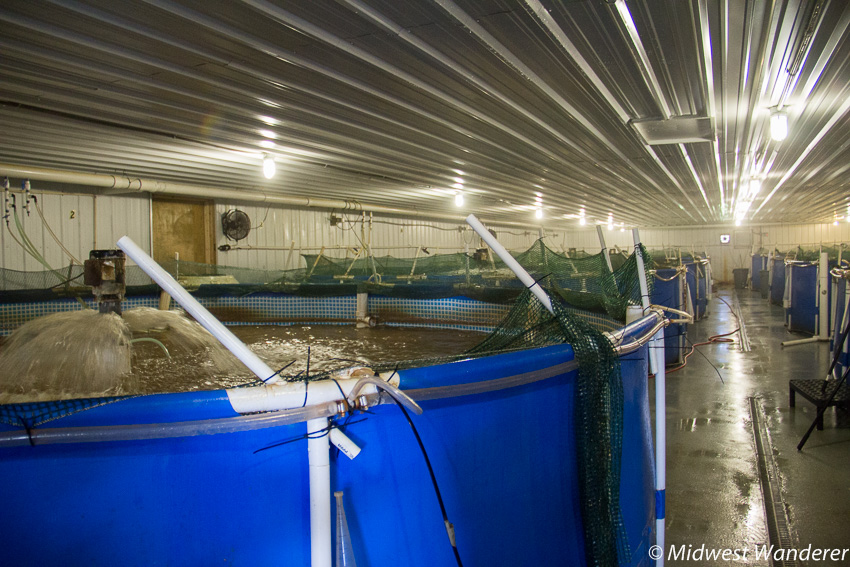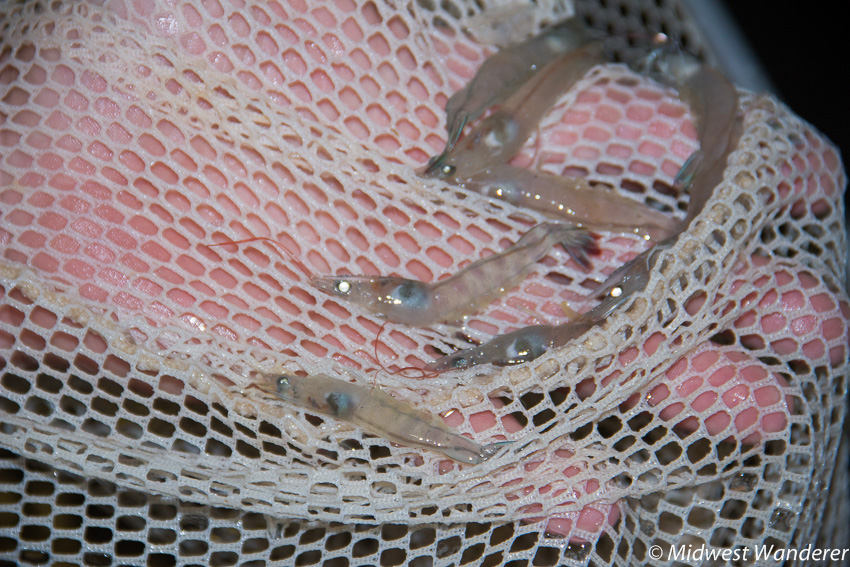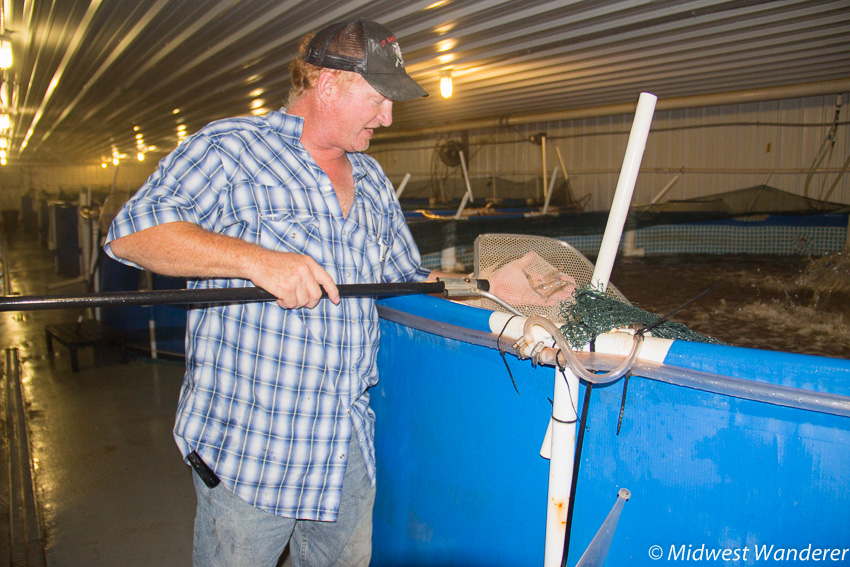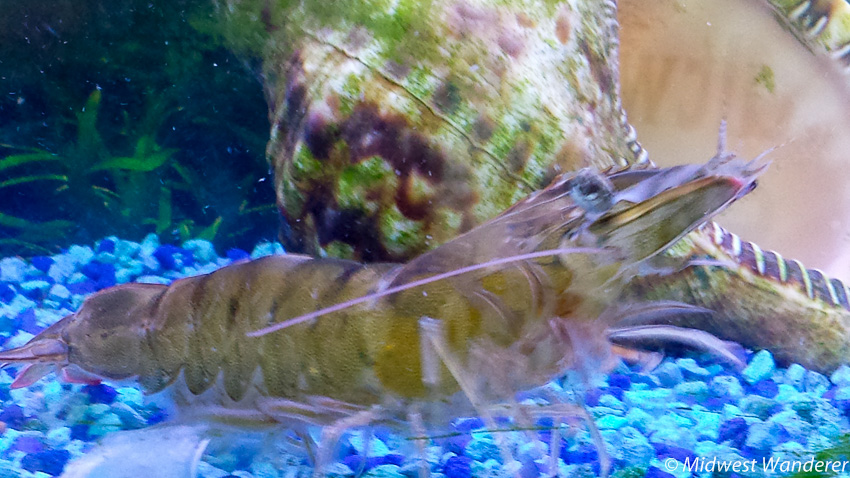Indiana, like most Midwest states, is big in agriculture. Soybeans, corn and cattle are common. But shrimp? Shrimp are salt water creatures. Indiana doesn’t have salt water. To my surprise, I found out there are a few shrimp farms in Indiana, including JT Shrimp in Wheatfield, where co-owner Scott Tysen gave us a tour.
Why raise shrimp?
Scott and his wife Leslie share the family farm with Scott’s dad, where they raise the soybeans, corn and cattle. However, the farm doesn’t produce enough income to support the entire family. Scott’s dad, who also farms the family’s land, recently retired from another full-time job. Scott was working construction, but when the construction industry slowed down, he turned to raising shrimp, something he had heard about and caught his interest.
About shrimp
I had never seen a live shrimp before, only already processed in the grocery store or served to me on a dish. The Tysens keep a couple of them in an aquarium so kids who come on tours can get a close-up look. The ones in the aquarium are about a year and a half old, so they’ve grown quite large.
Here are a few facts about shrimp in general:
- In the wild shrimp live three to five years
- They shed their skin every three to five days
- As you can see in the photo they have lots of what look like legs. The front ones, with claws, are used for eating, the middle ones are used for walking and the shorter, back ones are used for swimming.
- Shrimp are bottom feeders. In the wild they eat dead fish.
Touring the farm
The farm is actually a metal building with ten swimming pools used as tanks, each with a filtration system. Nine tanks are filled with shrimp. The tenth is a holding tank with water prepped to fill other tanks or to temporarily hold shrimp while another tank is being cleaned.
 Each tank holds 6,000 shrimp to start. Scott gets the shrimp when they’re about two months old from another farm that raises them from larvae. It takes about three months or so to grow to the point he can sell them, which is between 20 to 28 shrimp per pound.
Each tank holds 6,000 shrimp to start. Scott gets the shrimp when they’re about two months old from another farm that raises them from larvae. It takes about three months or so to grow to the point he can sell them, which is between 20 to 28 shrimp per pound.
 The Tysens have been raising shrimp for a couple of years and selling them for not quite a year and a half. It’s been a learning process, trying to get the water conditioned just right, the correct level of salinity and PH without using chemicals or antibiotics. Instead they use natural products like baking soda and glycerin. The survival rate, as low as 10 percent a few times, has been steadily increasing. Scott predicts it will take another few months to get to the 60 percent survival rate needed to turn a profit. Scott tests the water every day, making adjustments as necessary. He also works with the Purdue University Extension to learn best practices.
The Tysens have been raising shrimp for a couple of years and selling them for not quite a year and a half. It’s been a learning process, trying to get the water conditioned just right, the correct level of salinity and PH without using chemicals or antibiotics. Instead they use natural products like baking soda and glycerin. The survival rate, as low as 10 percent a few times, has been steadily increasing. Scott predicts it will take another few months to get to the 60 percent survival rate needed to turn a profit. Scott tests the water every day, making adjustments as necessary. He also works with the Purdue University Extension to learn best practices.
A few more fun facts
- Shrimp don’t like the dark. In the wild, shrimp come to the top of the water at night because they’re attracted to the moonlight. That’s why shrimp boats go out at night. At JT Shrimp, they leave the lights on all the time. If they’re turned off, the shrimp start jumping.
- Shrimp from the wild have a large mud vein that needs to be removed before cooking. The shrimp from JT Shrimp have the vein, but it’s so small it doesn’t have to be removed. The reason is because it doesn’t fill with mud like shrimp that scavenge at the bottom of the ocean.
- The shrimp at JT Shrimp are fed pellets made from soybeans and wheat. The shrimp can’t technically be called organic because the feed isn’t made from organic soybeans or wheat, but no hormones, chemicals or antibiotics are added. The water is run through several filters to take out algae, viruses and unwanted bacteria.
Buying shrimp from JT Shrimp
The shrimp doesn’t come out of the tank until you go to JT Shrimp to purchase it. He even takes them live when he sells them at nearly farmers markets.
 When you purchase the shrimp, he puts them in a plastic zip bag, which he can then put in another bag that has ice on it. JT Shrimp doesn’t clean the shrimp for you or put them directly on ice. That would make them food processors, which would encompass another whole set of rules to follow. They will tell you how to clean them and how to cook them. (If you’re boiling the shrimp, boil in beer rather than water; beer doesn’t shrink the meat.) Scott says their shrimp is sweeter than most shrimp. In fact, he has one customer who grew up on the East Coast and says it’s the best shrimp she’s ever had. Scott attributes its sweet taste to clean water and the glycerin that’s added to the water.
When you purchase the shrimp, he puts them in a plastic zip bag, which he can then put in another bag that has ice on it. JT Shrimp doesn’t clean the shrimp for you or put them directly on ice. That would make them food processors, which would encompass another whole set of rules to follow. They will tell you how to clean them and how to cook them. (If you’re boiling the shrimp, boil in beer rather than water; beer doesn’t shrink the meat.) Scott says their shrimp is sweeter than most shrimp. In fact, he has one customer who grew up on the East Coast and says it’s the best shrimp she’s ever had. Scott attributes its sweet taste to clean water and the glycerin that’s added to the water.
And what about the shrimp that die before he’s ready to sell them? He often sells them as fish bait.
If you go:
JT Shrimp is located at 4816 W 1450 N in Wheatfield, Indiana, about 70 miles southeast of Chicago. Check the website for additional details, including hours, tour information and price of shrimp.
Disclosure: Our visit to JT Shrimp was hosted by the South Shore Convention & Visitors Authority, and our admission was complimentary. However, all opinions in this article are my own. Photos by Skip Reed.
Thank you for reading Midwest Wanderer. Don’t miss a post. Enter your e-mail address below and click Subscribe to be notified whenever I publish another post. Subscription is FREE. After subscribing, be sure to click the link when you get the e-mail asking you to confirm. – Connie


A very special guide to shrimp understanding, especially the moon watching habit of shrimp. Very interesting. Thanks.
It’s always fun to learn about things you never really thought of learning about. I had no idea what they looked like when they’re alive.
I didn’t know any single thing about shrimps, not even how they look like! So much knowledge in your post, thank you for that!
I didn’t know anything about shrimp before I visited J.T. Shrimp either. And now I’ve visited my second Midwest shrimp farm in two months. Who knew?
I never knew boiling meat in beer is better than boiling it in water – thanks for the tip!
For shrimp, anyway, and brats. I always cook brats in beer before I put them on the grill.
How very interesting! I love shrimps and I never thought they would raise them in Indiana. One of the most unique visits I have encountered in my travel groups! Thanks.
And now I found a shrimp farm in Iowa, too. Who knew?
This is really cool! I’ve been fishing for
Shrimp before, but I’ve never seen a farm. Especially in Indiana!
Apparently shrimp farms are popping up in several places you would least expect to find them.
This was such an interesting read and I learned quite a bit. We just had a big shrimp dinner which made this post more meaningful. What a great place to visit and I would totally go here if in the area and I’m sure my kids would enjoy it too. I never would have expected this in the Midwest but what a great find.
It was a real surprise to me to find shrimp being raised in the Midwest, but apparently it’s becoming more common.